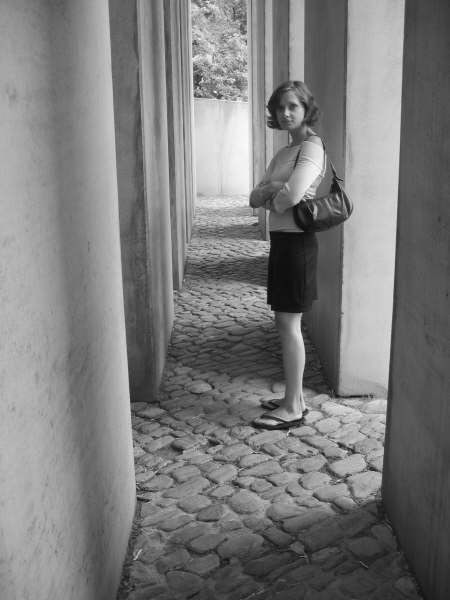 The architecture that a community chooses for its major cultural institutions reveals, of course, much about the values the society, community and particular designers want to infuse in that institution. The ROM website features a couple of interesting pages on the Museum's history; they teach that the original building was opened to the public on 19 March 1914. On the left is a photograph of a hand-lettered and illuminated presentation address, given as a gift by Toronto artist A.H. Howard to the Governor General of Canada on the occasion of his official opening of the ROM.
The architecture that a community chooses for its major cultural institutions reveals, of course, much about the values the society, community and particular designers want to infuse in that institution. The ROM website features a couple of interesting pages on the Museum's history; they teach that the original building was opened to the public on 19 March 1914. On the left is a photograph of a hand-lettered and illuminated presentation address, given as a gift by Toronto artist A.H. Howard to the Governor General of Canada on the occasion of his official opening of the ROM.We are all familiar with the notion that, when public museums began to emerge in force in the 19th and early 20th centuries, many of their architects turned to Neoclassical, or Gothic architectural forms.[1] New York's Metropolitan Museum of Art (opened in its current location in 1880), American Museum of Natural History (opened 1877), as well as The Cloisters (a museum devoted to Medieval Art, opened in 1914 and now a branch of the MET) provide a few examples. We all know that there is nothing indigenous about Classical and Medieval art & architecture in North America. Borrowing those European forms, however, lent credibility and authenticity to our young nations' new institutions.
Much, I'm sure, has been written on Architecture's role in Nation-building in the late nineteenth, and early twentieth centuries in Europe. For a couple of accessible examples, see Heather McMahon's M.A. Thesis (Central European University, 2004) on constructing a Hungarian national architectural style at the turn of the 20th century, and the blog post of South Hadley, Mass., Ph.D. student "Nathanael" on "A Catholic Style, A German Style" in the Rhine River region.
I think that "nation-building" through the use of value-laden architecture also happened on a much smaller scale than that of grand Gothic Cathedrals and national museums. American horticulturalist and writer Andrew Jackson Downing's 1850 book The Architecture of Country Houses, for example, aimed to educate the American middle class about the virtues of "uniting a simple and chaste Gothic style with forms adapted to and expressive of our modern domestic life." Downing ascribed a moralizing function to romantic architecture - one that he hoped would strengthen Americans' moral virtue.[2]
What's really interesting, though, is that in the midst of all this turn-of-the-century boasting about the value of old European forms in North American contexts, American librarian and museum director John Cotton Dana wrote in 1917 about "The Gloom of the Museum." Of particular interest are his arguments about how the museum edifice should be in harmony with its surroundings. His argument is worth quoting at some length here:
"A building of steel and concrete in a modern American city is not made an appropriate home of the fine arts by placing on its front the facade of one or the facades of half a dozen Greek temples or of 15th-century Italian palaces (...) In time we shall learn to insist that great public buildings like libraries and museums be erected as such and not as imitations of structures developed for quite other purposes, in other cities, in other times, and under limitations as to material and method by which we are no longer bound."[3]
It's remarkable that Dana's ninety year-old argument resonates when we think about the current trend of hiring big-name architects of international fame to renovate our museums. The ROM crystal and the Denver Art Museum extension are, in my mind, imitations of Libeskind's earlier designs - ones developed for other purposes, in other times, and in other cities. Are those who approve these design decisions trying to project a certain image for our cities, just as was Downing? Are they involved in some kind of contemporary "nation-building" themselves? Libeskind's crystal and another current, large-scale renovation, Frank Gehry's plans for the Art Gallery of Ontario will surely boost Toronto's reputation for 'world-class' architecture. But what cost do such unapologetically cosmopolitan projects as Libeskind's exact? Are there drawbacks to housing the ROM's collections in a building that could just as well be in Berlin? I'm still trying to think this problem through. Any thoughts?
-----------------------------------------------------------------------------------
[1]. As is likely fairly clear, I am no art history expert. The MET is a bit of a confusing case for me: I've seen reference to it as an example of Neoclassical architecture, but also to it as an example of Gothic Revival. Do any art historians out there care to clear up my confusion?
[2]. See Downing, The Architecture of Country Houses (New York: Appleton & Co, 1850), 440, as cited in Elizabeth Bradford Smith, ed., Medieval Art in America: Patterns of Collecting 1800-1940 (exhibition catalogue) Palmer Museum of Art, Pennsylvania State University (University Park, PA, 1996), 77.
[3]. Dana, "The Gloom of the Museum," in Gail Anderson, ed., Reinventing the Museum: Historical and Contemporary Perspectives on the Paradigm Shift (Walnut Creek: AltaMira Press, 2004), 22.



